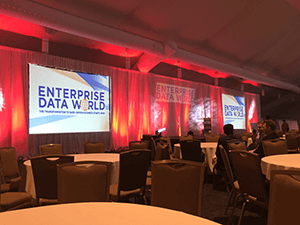It was a sunny week along the San Diego coast, and over 1,000 data professionals from around the globe gathered for the 2016 Enterprise Data World (EDW) conference. This year’s theme was about making a data transformation within organizations, and the enthusiasm surrounding this theme was palpable. From Chief Data Officers (CDOs) to IT directors, the attendees at this year’s conference were jazzed to hear all about using data to transform their businesses.
I was fortunate enough to be among the energetic conference goers. Here are my five key takeaways from EDW that will help you embrace data in your company:
- CDOs need to sit with the grown-ups.
Do you remember what holidays were like when you were a kid? More likely than not, you sat at the “kids’ table” with your siblings and cousins, using paper plates and plastic utensils. You looked your parents, aunts, uncles, and older siblings who’ve made the jump to the “adults’ table,” where they used fancy place settings and drank wine that flowed abundantly. It was every kid’s dream to sit at the adult’s table one day.
The same idea is true when it comes to the CDO’s position within your organization. In most companies, the role of the CDO is pretty new. As such, it’s unclear where the CDO fits in organizationally; some CDOs report to a CIO and some report directly into the CEO. But, what is clear is that not every organization includes the CDO in business-wide strategic decisions. In order for data initiatives to become a priority for your business, the CDO need to be seen as an equal to the rest of the C-suite and to be included in higher-level business decisions.
- CDOs need to demonstrate their value to business leadership.
Let’s face it, your CEO doesn’t think data is as cool as you do – and that’s okay! What is important is to understand their priorities. The CEO’s job is to increase revenue to the business and to deliver results to shareholders. They may not care about the carefully crafted data governance program you implemented, but they will be interested to know how much money that makes (or saves) the organization.
The CDO’s role is to simplify the details of their data program into a story the CEO can relate to. This story should frame how the organization collects data, how it uses that data, and how using this data creates value for the company.
How can you prove value in your company’s data? In a general sense, you can determine this by finding the delta between what you can do with it and what you can do without it. For instance, imagine your marketing team spends a million dollars each year on direct mail campaigns, yet the conversion rate is extremely low. Your CEO might be interested if using data to support the marketing team will bring that cost down while increasing conversions.
- You don’t need to lose your soul to leverage customer data.
Does using customer information to make decisions make you feel uneasy? Well, you’re not alone. In fact, this is a conversation happening at all levels of enterprises today.
What is important to remember, though, is that not all data use has to feel creepy. How? By following the Golden Rule. Before you go ahead and start using customer data to send targeted emails, ask yourself if you would be unsettled if you received that email. This is often the easiest gut check for organizations looking to use their customers’ data.
Another way to use data without that icky feeling is to anonymize it or to use it in the aggregate. By collecting information across your customer base, you can begin to analyze this information to see trends or to make correlations by demographics. By using information in the aggregate, your customers will also be more willing to share that information with you.
- Remember that your data has feelings.
It really easy to think of your customer data as numbers and alphanumeric characters. But it’s important to remember what’s behind your data: people!
Whether your company is a retailer, financial institution, education system, or government agency, odds are that you have countless databases with social security numbers, birth dates, addresses, phone numbers, and so on. Protecting the provenance of this data is vital to your organization’s reputation because customers are trusting you with their information. Any misuse or breach of customer data can cause diminished trust in your company and result in possible regulatory repercussions.
Think of your data as people every time you use it.
- Be your company’s “data provocateur."
Sometimes you need to light a fire to get things done. At this year’s Enterprise Data World, the closing keynote addressed the importance of becoming your company’s data provocateur. The data provocateur is a catalyst for change and relentlessly pursues what they feel will benefit the business. They question the status quo, and they inspire people to think about using data in new ways.
Unlike a visionary, however, the data provocateur may not have a far-reaching plan for the organization, but they know how they can improve upon on a process or a product in the immediate future. By exercising this role with tact, you can cement yourself as a leader and innovator within your company.
This year’s EDW conference was jam-packed with sessions covering big data, data governance, data management strategies, data ethics, and many other related topics that help organizations make the most out of their information. I was thrilled to hear from these leaders in the enterprise data community about their data initiatives and challenges.
Let us know what you thought about this year’s Enterprise Data World! Did anything surprise you?






